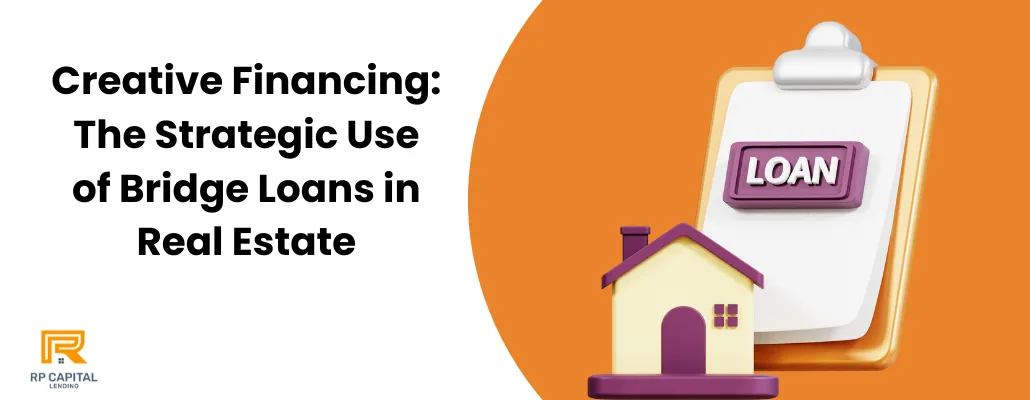Blog

Creative Financing: The Strategic Use of Bridge Loans in Real Estate
In the dynamic world of real estate, bridge loans emerge as a pivotal financing tool, offering unique solutions to both investors and homebuyers. This comprehensive guide delves into the strategic use of bridge loans, shedding light on how they can serve as a crucial link in real estate transactions. From providing immediate funding to bridging the gap between purchase and long-term financing, bridge loans embody flexibility and speed.
This article aims to explore their advantages, navigate potential risks, and illustrate their practical application in real estate, offering invaluable insights for those looking to optimize their property investments.
Understanding Bridge Loans: A Brief Overview
Bridge loans, a pivotal tool in real estate finance, are short-term loans used primarily to 'bridge' the gap between the need for immediate funds and the future availability of financing. These loans are especially beneficial in real estate due to their prompt availability, allowing investors and buyers to capitalize on time-sensitive opportunities. Unlike traditional loans, bridge loans offer a quick resolution to funding challenges, providing the agility needed in the dynamic real estate market.
The Role of Bridge Loans in Real Estate Financing
How Bridge Loans Fill the Financing Gap
Bridge loans are crucial in real estate transactions where immediate funding is paramount. Their essence lies in providing quick capital for short periods, making them ideal for scenarios like auction purchases or urgent property acquisitions. By offering a temporary financial 'bridge', these loans enable investors to seize opportunities without the lengthy process and stringent requirements typical of conventional bank loans, thus filling a vital gap in real estate financing.
Advantages of Using Bridge Loans in Property Deals
Speed and Flexibility: Key Benefits
The primary advantage of bridge loans is their rapid processing and adaptable terms. Real estate investors often turn to these loans for their ability to facilitate swift property transactions. Whether it’s for acquiring a property at an auction, undertaking urgent renovations, or seizing an undervalued property deal, bridge loans provide the necessary funds promptly. This speed, coupled with the flexibility in terms and conditions, makes bridge loans a highly attractive financing option in the real estate sector.
Assessing Risks and Mitigating Factors
Navigating the Challenges
While bridge loans offer significant advantages, they also come with risks like higher interest rates and shorter repayment periods. Borrowers must carefully evaluate these risks, considering factors such as the feasibility of their exit strategy and their ability to manage the higher cost of borrowing. Understanding these risks and planning accordingly is essential to effectively utilize bridge loans in real estate ventures.
Bridge Loans vs. Traditional Financing
Comparing Loan Types
Bridge loans and traditional financing serve different needs in the real estate market. Traditional loans, typically characterized by lower interest rates and longer repayment terms, are well-suited for stable, long-term investments. Bridge loans, on the other hand, are designed for immediacy and flexibility, catering to short-term financial needs with a higher cost. The choice between these financing types depends on the specific requirements and circumstances of the borrower.
Creative Strategies for Utilizing Bridge Loans
Innovative Approaches in Real Estate
Savvy investors use bridge loans not just as a financial stop-gap but as a strategic tool for real estate investment. These loans are particularly useful in scenarios like property flipping and rapid property enhancements, where quick access to funds can make a significant difference. By understanding how to strategically employ bridge loans, investors can maximize their returns in the real estate market.
How to Secure a Bridge Loan: A Step-by-Step Guide
The Application Process
Securing a bridge loan involves a clear understanding of the lender’s criteria, thorough preparation of necessary documentation, and a compelling presentation of the loan request. This section provides a step-by-step guide to navigate the application process, offering practical advice to enhance the likelihood of securing a bridge loan.
Legal and Regulatory Considerations
Navigating Legal Frameworks
A thorough understanding of the legal and regulatory aspects is crucial when dealing with bridge loans. This includes being aware of the terms of the loan agreement, legal obligations, and compliance with relevant regulations. Knowledge in these areas ensures a smooth and legally compliant transaction in the real estate market.
Expert Tips for Bridge Loan Management
Best Practices and Advice
Effective management of a bridge loan requires strategic planning and financial prudence. This section offers expert advice on how to manage a bridge loan, including tips on repayment planning, risk management, and optimizing the benefits of the loan.
The Future of Bridge Loans in Real Estate
Emerging Trends
The future of bridge loans in real estate looks at how these financial instruments are evolving in response to market dynamics. This section explores upcoming trends, potential changes, and the future role of bridge loans in real estate financing.
Conclusion: Enhancing Your Real Estate Portfolio
In conclusion, bridge loans stand as a versatile and strategic tool in the realm of real estate financing. Their ability to provide swift financial support bridges critical gaps, enabling investors and buyers to capitalize on timely opportunities. While they carry inherent risks and higher costs, their benefits in facilitating quick transactions and offering flexible terms are undeniable. By understanding and effectively managing these loans, investors can significantly enhance their real estate portfolios. This guide underscores the importance of bridge loans in modern real estate, highlighting their potential to transform investment strategies and drive successful property dealings.
FAQs on Bridge Loans in Real Estate
1. What is a bridge loan in real estate?
A bridge loan is a short-term financing option used in real estate to provide immediate funds until long-term financing is available.
2. How quickly can you obtain a bridge loan?
Bridge loans can often be arranged quickly, typically within a few weeks, depending on the lender's requirements and the borrower's readiness.
3. What are the main advantages of using a bridge loan?
The main advantages of bridge loans are their speed of funding and flexibility in terms, ideal for time-sensitive real estate transactions.
4. Are bridge loans more expensive than traditional loans?
Yes, bridge loans generally have higher interest rates and fees compared to traditional long-term financing options.
5. Can bridge loans be used for residential property purchases?
Yes, bridge loans can be used for both residential and commercial property purchases, offering flexibility in various real estate dealings.
RP Capital Lending is a d.b.a of RP Capital Partners Inc (NMLS # 2469193) | Privacy Policy
Copyright © 2022. All Rights Reserved.
Disclaimer: Loans only apply to non-owner occupied properties. Rates, terms and conditions offered only to qualified borrowers, may vary upon loan product, deal structure, other applicable considerations, and are subject to change at any time without notice.

